Here’s a look at some of the key panel sessions and highlights from day one of WasteExpo.
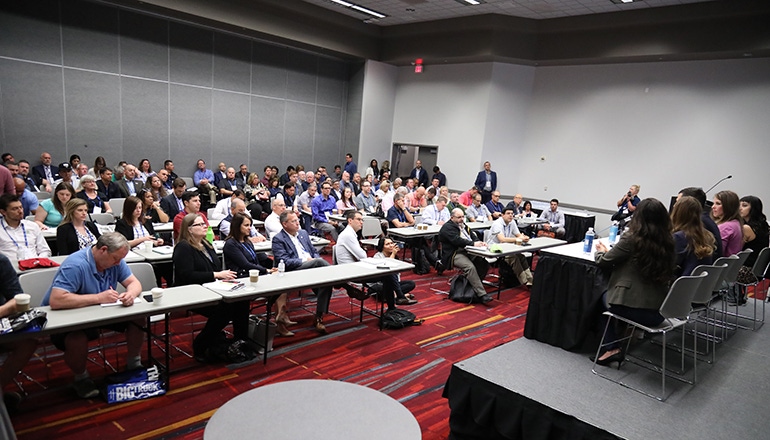
WasteExpo 2019 officially kicked off on May 6, and literally every seat was taken at the session: “Post China & the Current Status of Recycling.” Here is a look at that session as well as some additional key highlights from the first day of WasteExpo.
Katie Sandoe of Lancaster County, Pa., Solid Waste Authority; Byron Luo of WinFibre U.S.; and Cheryl Coleman of the U.S. Environmental Protection Agency (EPA) Resource Conservation and Sustainability division collectively addressed how municipalities are dealing with the impact of China’s crackdown on commodities, what the future may hold for exports of fiber and other hot topics fueled by China’s fairly recent restrictions and bans.
China has stopped taking mixed paper altogether and revised its contamination threshold to 0.5 percent. Loads of commodities that do move are being painstakingly inspected.
“Now, a 25 percent tariff is in place, and we got a Twitter [post] saying this will last longer,” Luo told attendees.
At customs, inspectors walk around with cameras to trace noncompliance. And they are using scanners.
“If it smells, they won’t unload it, and there is a major inspection of prohibitive materials like medical waste,” he said.
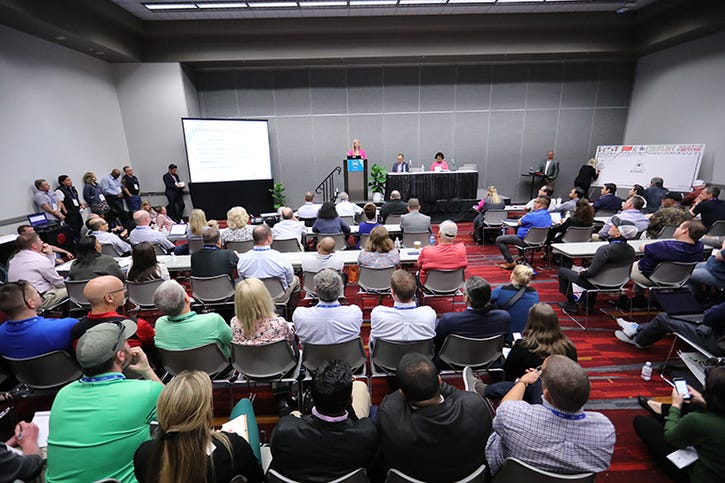
The policy has impacted not only trade opportunities for the U.S. but China’s mills, he said, telling of a paper shortage and the near doubling of waste paper prices. So, it’s a volatile market, but in the meantime, China is modernizing collection and sorting.
“Where did the waste paper go? I just speculate but I think U.S. mills have cleaning systems to handle more mixed paper. And a lot is used in India and Southeast Asia to make recycled pulp. Though I am not sure if this activity will last long,” said Luo.
Last year, production and consumption in China declined 10 percent, but he believes over the long term, there will be growing markets.
“Don’t give up,” Luo told attendees, adding the good news is that the U.S. is more conscientious of what’s in the stream following a period where bales were being shipped out with 5 to 8 percent contamination levels. “You are working on it, and we are too. We should be able to work through this.”
“China was not the crisis when National Sword went into effect; it just illuminated an existing crisis, which is people did not know how to recycle, and we ended up with a large contaminated stream,” said Sandoe.
Still, the authority, which services 850,000 residents and manages, through contracts, more than one million tons annually, started to feel the impact of China’s crackdown in early spring 2018.
“We said we can’t do nothing and wait for it to shake out; we need to react. We saw contamination in the bin as the primary area to address,” said Sandoe.
The question became, how would they get the community to begin to recycle appropriately? The first part of the plan was to simplify the recycling process and create standard guidelines for every municipality. Four materials types were targeted: cardboard, metal, glass bottles and jars and plastic containers with necks. Simple recycling directions were devised incorporating few words, instead relying more on shapes, colors and images.
The authority also focused on fostering public and private collaboration, believing this critical to ensuring recycling remains sustainable for the long term.
“One of the first things we did when we were looking to overhaul the program is meet with key leaders. We asked: What are you seeing? What are your challenges financially from a processing perspective?” Sandoe told attendees.
The effort to standardize the message has entailed meeting regularly with materials recovery facilities (MRFs), haulers and municipalities. “We needed everyone to relay the same message,” emphasized Sandoe.
The municipalities don’t typically have a marketing and education budget, so the authority provided a universal logo.
“Don’t be afraid of the media,” Sandoe went on to advise. “They can be allies if you help them understand. We got incredible coverage on TV and in print, and [our story] got picked up by The Wall Street Journal.”
Among her last tips she shared: changing behavior takes time. She said she thinks it could take three to five years to see the needle move.
“It takes patience and repetition. But keep energy and interest around this. And keep it simple and consistent,” she added.
EPA is trying to work with municipal governments on a tool to manage its recycling assets better now that it has less places to send materials. The agency is looking to release some sort of resource in November to help strengthen markets, according to Coleman.
“We are trying to help with film in particular. It creates a safety issue, and wages and time are lost when you have to stop machines and pull it out,” she told attendees.
Additionally, the agency is trying to come up with ways to encourage people to buy materials with recycled content, incentivizing with funding that requires following consumer procurement guidelines.
We throw out $9 billion worth of material, she said. While she acknowledges a need for education, updated infrastructure and solid markets, she made a point: “Recycling is not dead. There is data showing $6.7 billion in annual revenue from recycling tax incentives. There are jobs and opportunities. So, my appeal is to work together [toward making recycling sustainable].”
During “Change is Coming: Insights into C&D Trends,” William Turley of C&D Recycling Association (CDRA); Timothy Townsend of ESSIE, University of Florida; and Tom Miles of U.S. Biochar Initiative explained emerging opportunities in construction and demolition (C&D) recycling and barriers to taking advantage of them. Then, they touched on processes and systems to get around those barriers. A full room of attendees also heard about an up-and-coming material, which is a byproduct from processes such as burning wood that’s used in applications from soil amendments to capture heavy metals in dirt.
C&D is the fastest growing new opportunity for landfill diversion, but not many municipalities know how to tap into it due to challenges posed by what’s a new frontier for them.
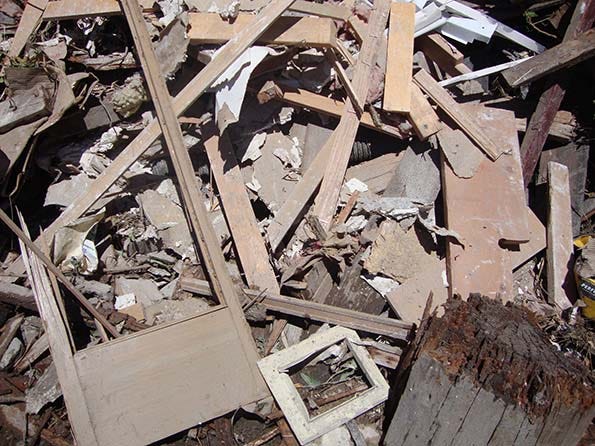
construction-materials.jpg
Two of the biggest challenges for the industry, said Turley, are finding better end markets for products like wood, C&D fines and shingles—and expectations of the government and general public, which he said are not economically viable or supportive of what the industry can do.
Fines are getting special attention among industry stakeholders—soil, brick and other small pieces created at processing facilities.
“[Processors] use trommel screens, and as material goes down the picking line, some smaller pieces flow through that are not part of the aggregate product they want to sell. So, how do they make the best fines possible rather than just dispose of these materials as residue?” Townsend asked.
He answered the question with news from the field: “Recycling facilities are targeting concrete aggregate, which is plentiful in fines. Material may also be screened out to use as daily cover, or if they can be backhauled, fines might be used as soil or agriculture amendment.”
But he told attendees, what it’s mixed with can be a problem. He gave the example of concrete aggregate that can be mixed with wood, gypsum and other components.
Gypsum, in particular, can be difficult; under anaerobic conditions, hydrogen sulfide can be created, which is highly odorous and dangerous in high concentrations.
Every state has its own guidelines to characterize environmental risks. And CDRA members ran into this problem often. For instance, in Ohio, you can find specific chemical quality guidelines but more generic [guidelines], based on many materials, in other states.
That does not leave entrepreneurs without options, he went on to say.
“You can make better fines products to control risk or do a site by site risk basis. You can be smarter in the types of material you bring in.”
Further he said, “We thought if we screen material more, we can create a better product and found we can.”
Chemicals like lead and arsenic build up in dusty conditions. But by screening small particles out of fines, processors can reduce concentrations below target levels, which has been demonstrated with organic led and organic chemicals.
He advised that another way to get cleaner, useable aggregate from fines is by utilizing washing yards.
“You go to a more uniformly graded material by washing, and you pull out just the fraction of reusable material you want. And your density increases, so it can be used as structural fill material,” he said, though cautioned this process can be costly.
He left session attendees with the thought that C&D fines make up 20 percent of the mass—those who find markets for it avoid huge tip fees and create valuable products.
Miles took the session to the topic of biochar, including processes to make it from urban residues (e.g, involving burning wood). It can be converted to value-added products such as agriculture applications.
It's charcoal cooked for a long duration, resulting in material that can hold on to moisture and nutrients. As a soil application, in small amounts, it promotes growth of roots to make healthy plants. Combining it with other soil ingredients results in more nutrients and microbial components.
Miles shared a story from California about how it’s used there with compost to increase water holding by 25 percent, providing relief through droughts.
“Minneapolis is using biochar as part of a stormwater filtration system for E. coli. My understanding is it holds onto organisms that consume E. coli. And there are other filtration and reduction uses,” Miles told session attendees.
It’s also used at treatment plants for odor control. It’s played a role in non-soil applications like animal feed, and it’s finding its way into building products.
“And a little biochar goes a long way. It’s like a catalyst, added in small layers with other materials rather than using it in high concentrations,” said Miles.
In a session called “Robots & Recycling: A Dynamic Duo,” Bill Keegan of Dem-Con; Matanya Horowitz of AMP Robotics; Michael Gross of Zanker Recycling; and Will Hancock of Plexus Recycling Technologies discussed how far robotics have come in the recycling world in the past two years. Moderated by Nathiel Egosi of RRT Design and Construction, the session also was an opportunity to hear projections of what the future holds for this “smart” technology.
Robotics have the ability to automate the sorting process within the framework of existing operations. So, said Horowitz, “We think the technology has a lot of potential to help facilities in their current environment.”
Machine learning, or artificial intelligence (AI), distinguishes materials’ features while avoiding the need for expensive spectral infrared sensors.
“We can identify material in highly comingled conditions and not only see individual objects and identify their different material types and resins, but we can get a sense of shape and texture,” he said.
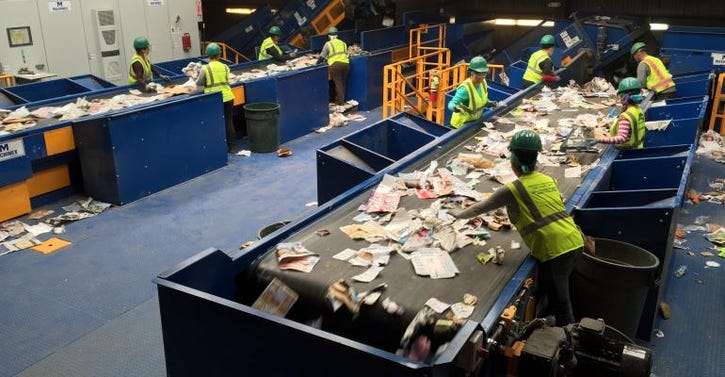
9. What Robotics and AI Could Mean for the Future of the Industry
AI can pull data from recycling facilities across the country, enabling information to be shared from one facility to another. Horowitz’s facility in Minneapolis learns from his Denver facility.
The robot itself can pull cartons, containers, cans and metals. And it can clean polyethylene terephthalate on the line.
“What we are especially excited about now is that the robots are going onto fiber lines where there has been a lot of manual labor,” Horowitz told attendees.
Between increasingly tightened commodities quality standards, worsening labor shortages and high logistics costs, the question is what do we do? Keegan asked a room full of attendees.
“We decided to look at automation to reduce the need for manual labor and improve efficiency of our operations,” said Keegan.
From an operator's perspective, he said, robotics has a smaller footprint than optical sorting and is easy to add to an existing system; it simply had to be installed on top of his established setup. And if the robot were to be down, the rest of the system remained operational. It also has enabled eliminating physically demanding, manual sorting jobs where there is potential for injury.
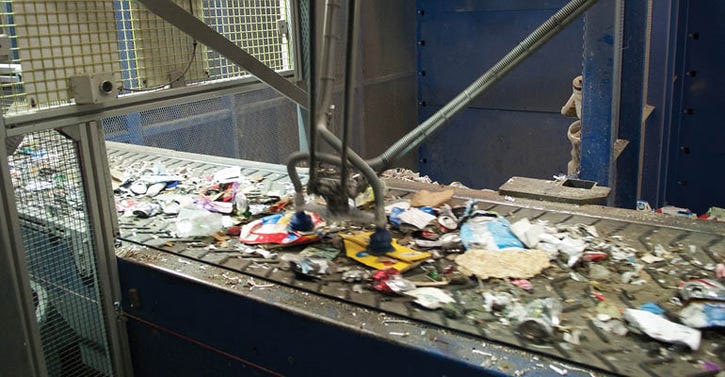
“There are challenges we have to continue to solve. The single-arm robot does have missed picks, and the robot takes up about twice the space of a person. But it’s a fraction the size of an optical sorter. And it has come a tremendously long way in the two years we’ve had it,” he said, pulling up a video showing the system sorting cartons on one belt and simultaneously sorting milk jugs on another one.
Zanker developed a demolition processing operation. Over time, it added sophisticated sorting systems.
“We invented the rocket to sort wood from rock, but it had limitations of cardboard and sheetrock," said Gross. "We needed a system that takes us out of the water bath system; it didn’t work on this application.”
Most recently, Zanker built a state-of-the-art plant that processes around 65 tons an hour, but it falls short of seeing the plant achieve its 90 percent recycling target.
“In this industry, it’s about upgrading systems. And artificial intelligence is becoming a part of it,” said Gross. “For us, it replaced the water bath system.”
Plexus, who concentrates on the C&D market, has a robotics waste sorting system. But there are preliminary steps before its Zen robot does its job, including shredding materials to get them to a manageable size and a ballistic separator that eliminates 2D materials before the robot receives what’s remaining.
Rock, brick, wood and metals bounce backward and on to a separate line. They are bunker fed to the robots that sort the material. The AI system realizes what it picked wrong and reclassifies. Robots can be controlled from devices and operators can change applications.
“Our fast picker recognition software works to support quality control for multiple materials. And the robots learn more every day,” Hancock told attendees. “We are in infancy of developing robots’ full potential.”
In a session called “What’s New in Waste-to-Energy,” Brian Gilhuly of RePower South; Mike Hart of Sierra Energy; and Mike Moran of Dow Chemical Company discussed some of the most state-of-the art energy conversions out there, including two new projects.
Moderated by Jeff Palutis of Custom Environmental Consulting, the session was a chance to learn how some innovators are working to get buy in on their ideas. And it was a chance to learn how these technologies are addressing tough problems around some materials while generating clean, renewable energy and reducing landfilling.
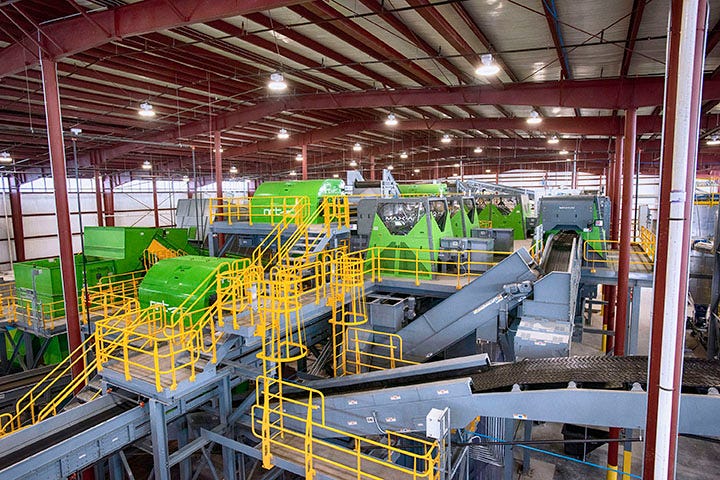
Sierra Energy was an early user of 100 percent biodiesel but wanted to do something even better for the environment, so it came up with a plan to make fuel out of garbage. What it ended up producing is 20 times cleaner than outlined by California fuel standards. The fuel is made through a process called FastOx.
“We get rid of oxygen and operate at very high temperatures, so everything breaks down. We can make hydrogen for fuel vehicles cheaper than fossil fuel, and we can make fertilizer. Metals melt, and we recover them,” said Hart.
The technology has been demonstrated with tires, railroad ties, hazardous waste, C&D waste and medical waste.
The first commercial facility just launched in Monterey, Calif.—a 20-metric-ton-per-day gasifier that makes electricity, renewable diesel and renewable hydrogen. California has the tightest environmental regulations in the state, and Sierra’s project came with support of Gov. Gavin Newsom, the Sierra Club and the Natural Resource Defense Council.
“It’s much cleaner than natural gas; it will have emissions but substantially less than fossil fuel,” said Hart. “You don’t need many more operators as systems get larger and efficiency goes up as well. But it’s not a cheap endeavor. A 1,000-ton-per-day system, which would generate 50 megawatts of continuous power would cost $80 million to $100 million to build.”
Gilhuly gave an insider’s view of a facility that became fully operational last month. His plant in Berkeley County, S.C., recovers and processes recyclable municipal solid waste and turns what’s left into an engineered solid fuel that is sold as a substitute for coal.
The process to make this fuel involves no chemicals and no mass burn or other thermal conversion.
“In mass burn, you invest in separation and building a power plant. It’s a lot of capital up front and may work in some environments,” he said. “But we wanted to know, how can we create a plant to make fuel from nonrecyclable material in the stream you can sell and not have to spend that capital?”
Recyclable materials are recovered with equipment like infrared optical sorters and robotics. Engineered fuel is made from what’s left, which is fed into a system that reduces it and eliminates moisture.
“This is clean, low-carbon engineered fuel made specifically for the client, so we must know their needs and design for the environment they will burn it in,” said Gilhuly.
For now, he has short-term contracts.
“[Clients] want to know we will consistently produce fuel before making long-term commitments. This is our second plant, and we will build as many as we can,” he added.
Gilhuly’s customers pay about $40 per ton, comparable to their disposal costs prior.
“We think it’s scalable. We are limited by transportation costs, so we are trying to find communities with enough waste and combustion capacity,” he said. “That and getting communities to accept and embrace it have been the challenges.”
Dow Chemical believes landfills should be a last resort for plastic, so it created its Hefty EnergyBag, which was Moran’s topic. The bags are used at curbside to collect hard-to-recycle plastics for energy recovery through pyrolysis or for recycling.
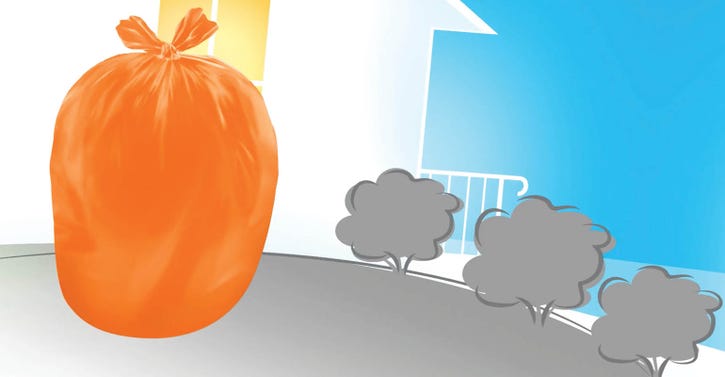
“In 2015, we collected 8,000 EnergyBags and made 512 gallons of synthetic fuel. It was just to see if it was feasible. We’ve since expanded to three cities,” Moran said. The bags will come to Lincoln, Neb.; London; and Ontario, Canada, later this year.
“We’ve delivered bags to 125,000 households so far and diverted 357 tons of plastic. It’s small, but we’ve proved we can make it work,” said Moran.
During "A Fresh Take: How Rising Leaders See the Waste Industry's Future,"Waste360 Editorial Director Mallory Szczepanski discussed a number of industry-related topics with Kristin Kinder of Wastequip, Andrew Rumpke of Rumpke Waste & Recycling, Tania Ragland of Republic Services and Michelle Salas of Lady Green Recycling Co., all of whom are 2019 Waste360 40 Under 40 award recipients. The panelists shared their insights on how they have seen the industry change, what the future may have in store for the industry, some of the challenges and opportunities they are seeing, some of the misconceptions about the industry, best practices for staying safe on the job and much more. Look out for their individual Q&As that will be posted throughout the year!
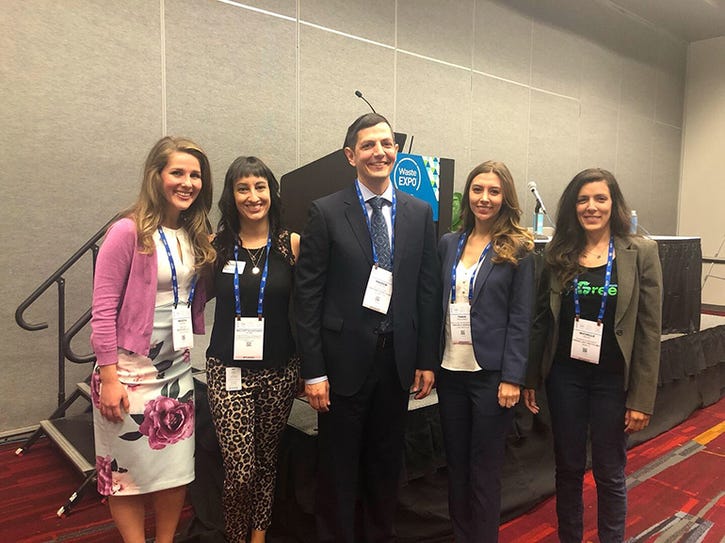
While education sessions were in full swing, Szczepanski went live on Facebook with Bryan Staley, president and CEO of Environmental Research & Education Foundation; Kirk Sander, vice president of safety and standards at the National Waste & Recycling Association; and Marty Bryant, CEO of Wastequip. Check out the videos below:
About the Author(s)
You May Also Like






